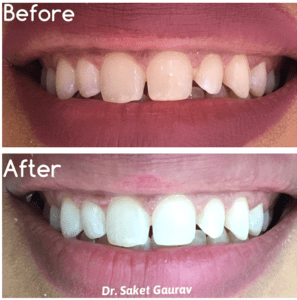Tooth Sensitivity- Causes and remedies
Dr. Saket Gaurav
B.D.S.(India), PGD.Ortho, PGDAD(Cosmetic)
International Dental Practitioner
DENTAL MAKEOVER, Delhi NCR
If drinking a glass of cold water, eating ice cream or drinking hot coffee gives you a painful shock like unpleasant sensation or experience, then for sure its sensitivity. Tooth sensitivity is one of the most common issue troubling mostly youngsters and adults. In certain cases the teeth sensitivity is also aggravated by consuming sweet, acidic food items or even with air on few occasions.

A healthy teeth, is made up of three different layers-
Enamel: The outer most layers, very hard and highly mineralized layer protect the crown portion of the teeth. No nerve innervations present in this layer.
Dentine: It’s the second layer beneath enamel and is less dense than enamel and contains microscopic tubules (small hollow tubes or canals).
Pulp: The innermost layer mainly comprised of blood vessels and nerve innervations.
Reason for sensitivity: When outer protective layer of enamel is lost these tubules allow hot, cold, acidic or sticky foods to reach the nerves or pulp inside the tooth. Dentin may also be exposed due to gum recession. This results in hypersensitivity.
The good news is that if precaution, care and dentist consult is taken at the right time it can help you get away with tooth sensitivity. Here is a list of the most common causes of tooth sensitivity with tips on what you can do to minimize the pain.
Decayed tooth or Cavities: The virulent bacteria those are present in tooth decay produce acid, which accelerates the enamel breakdown resulting in cavity formation. Once the cavity starts getting deeper and deeper and reached close to the pulp (nerves), tooth sensitivity or pain may be experienced. It is very important that you see your dentist if you suspect you have decay in your teeth. You will be advised for tooth fillings, tooth crown or root canal treatment.
Gum disease: Using a very hard bristled brush, applying extra force during brushing and smoking may cause recession of gums, which is one of the most common causes of tooth sensitivity. There are dental procedures that can treat gum disease, the already receded gums as well as changes in oral health habits such as careful brushing and quitting the habit of smoking can help.
Teeth grinding: People suffering from Bruxism (the grinding, of the teeth most commonly during sleep or awake) can experience a wearing down of the enamel on their teeth. This results in exposing the dentin layer, which leads to the tooth sensitivity. Using a mouth guard might help.
Citrus/Acidic foods: Consuming to much of citrus and acidic food items causes erosion of the enamel layer leading to teeth sensitivity. Try to avoid foods such as citrus fruits, pickles and tomato sauce and other acidic food items. Use of desensitizing toothpaste might help.
Plaque: a sticky deposit on teeth in which bacteria proliferate. Excessive plaque accumulation on the tooth surface may lead to tooth decay and once this occurs, your teeth may become sensitive. Maintaining good oral hygiene habits and visiting your dentist every 6 months for cleanings and check up will help in keeping a healthy oral hygiene.
Cracked/Fractured tooth: Trauma may result in the fracture or crack of the tooth, once the fracture line gets deeper involving the dentine and pulp, you may experience sensitivity or pain. It is important to consult with your dentist to discuss treatment options which will depend on the extent of damage, treatment like tooth fillings, tooth crowning or root canal treatment if the nerves are involved may be advised.
Applying force while brushing: Brushing with too much force/pressure can wear away the enamel layer, exposing the soft dentin underneath leading to sensitivity. You should try to brush more gently or with a soft bristled toothbrush. If the dentin layer is already exposed, consult your dentist for treatment options.
Excessive use of Whitening toothpaste: Some of us think that using the whitening toothpaste will whiten the teeth, that’s true it does whiten but the chemicals present in it also causes chemical erosion leading to wearing away of the enamel layer and resulting in teeth sensitivity. You may switch to fluoride or desensitizing toothpaste instead. If the discomfort persists then consult your dentist.
Mouthwashes: Few mouthwashes contain alcohol or other chemicals that can aggravate sensitive teeth. Make sure that you opt for a non-alcoholic standard mouthwash.
Recent dental procedure: it is normal to experience increased tooth sensitivity after a dental procedure like tooth fillings, cleaning etc. This is nothing to be concerned about unless the sensitivity does not disappear on its own. But if it doesn’t then consult your dentist.

